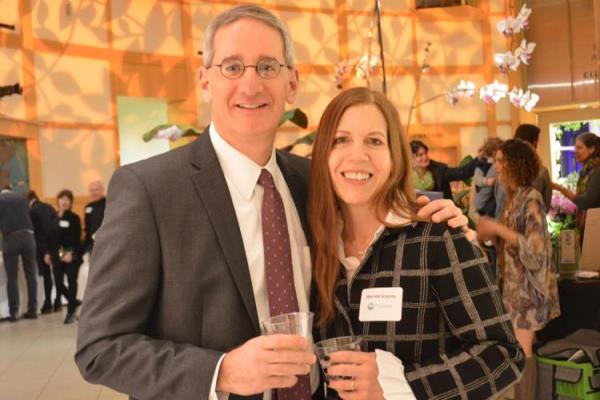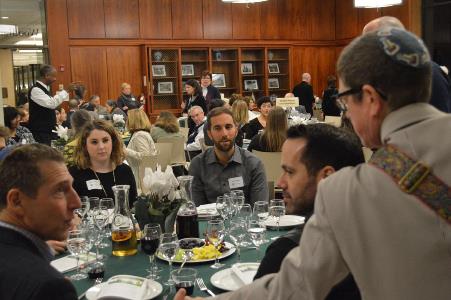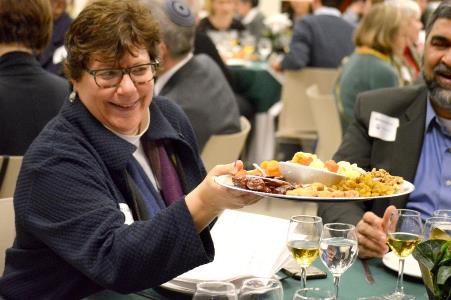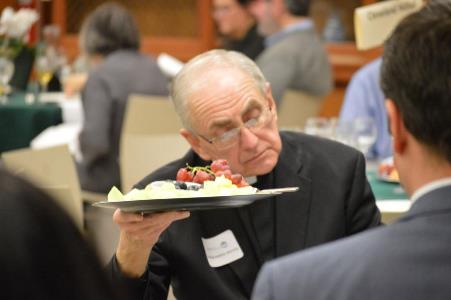02/14/2019
Stories Shared at Interfaith Tu b’Shevat Seder
- Share This Story
Article reprinted with permission from Cleveland Jewish News.
By Jane Kaufman

Brad and Heather Schlang relax in the lobby of the Cleveland Botanical Garden in University Circle prior to the Tu b’Shevat seder. He is the chair of the Community Relations Committee of the Jewish Federation of Cleveland, which co-hosted the event. CJN Photos/Jane Kaufman
About 120 people gathered at Cleveland Botanical Gardens Feb. 12 to bless trees and their fruit, drink, sing and share their stories of connection to trees and nature.
Israel’s national flower, the cyclamen, was the centerpiece at each of the tables at the fifth annual Interfaith Tu b’Shevat Seder, co-hosted by the Jewish Federation of Cleveland and Holden Forests & Gardens.
“As a kid I just loved being outdoors,” said Brad Schlang, chair of the Community Relations Committee of the Jewish Federation of Cleveland, which co-hosted the event. “This was the time of year we would make contributions to plant trees in Israel. We all still have our certificates commemorating those first steps to improve the environment.”

Rabbi Rosette Barron Haim led the event with Brynna Fish leading songs and accompanying blessings.
Haim framed the seder with explanations of rituals. She said on Tu b’Shevat, literally the 15th day of the Hebrew month Shevat, Jews eat 15 kinds of fruit, one for each day leading up to the festival. She also spoke of the four cups of wine, which call to mind not only the Passover seder but also “four seasons, four corners of the earth.”
Participants took turns reading from a Haggadah partly of their own making, which featured readings from the 15 environmental, faith and cultural groups represented at the seder.

“In Vayikra, we are told to wait three years before harvesting a newly planted tree,” said Adi Shiloh, tree care coordinator at Holden Forests & Gardens. Shiloh, the daughter of Israelis, who grew up in rural Ohio, said this is consistent with current practice.
“...The first three to five years after a tree is planted are the most integral for its survival,” she said. “The trees need regular watering, proper mulching, gentle, corrective pruning, and maintenance in that time period for a much healthier future and greater rate of survival.”
Courtney Blashka, community forester for Holden Forests & Gardens, spoke of the benefits of trees and of the initiatives her organization is undertaking, including the Cleveland Tree Plan, a “collaborative community effort to increase the city’s tree canopy coverage from its current level of only 19 percent to at least 30 percent by 2040.”
Many speakers representing environmental groups spoke of their initiatives.

The Rev. Joseph Hilinski, delegate for Ecumenical and Interfaith Affairs at the Catholic Diocese of Cleveland, and Masroor Malik, a board member of The Chagrin Valley Islamic Center in Solon, both made blessings prior to the meal.
“As we come together as brothers and sisters in various faiths today, oh Lord, please give us the compassion and understanding,” Malik said. “Give us the strength to work for the good of all humanity and against what is harmful to all of us, and guide our leaders to make wise and fair decisions.”
Mindy Feigenbaum, Northern Ohio director of the Jewish National Fund, said the Jewish National Fund has planted 270 million trees in Israel. When she asked people to raise their hands if they had ever planted trees in Israel, many in the room held their hands high.
Publisher’s note: Rosette Barron Haim is a member of the Cleveland Jewish Publication Company Board of Directors.

